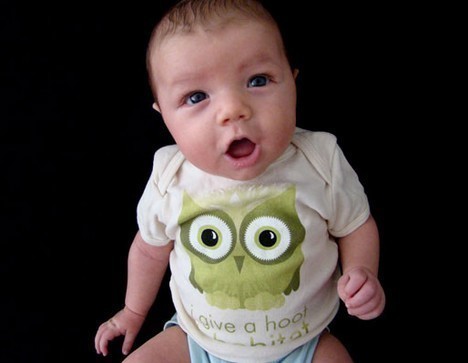Ok..I noticed that there weren't a lot of articles here, so I decided to add one. I found this webpage a few minutes ago, and it was actually a bit interesting. So I decided to post this webpage here, in case there were any expecting mothers here who are curious about whether they were having a son ou a daughter. This is for them, and anyone else here of course :)
When it comes to guessing your unborn baby's sex, myths abound, but there are a few ways to know for sure.
par Colette Bouchez
WebMD Feature
Reviewed par Cynthia Haines
From almost the moment a woman discovers she's pregnant, the guessing games begin.
"Will my baby have my nose -- my partner's lips -- my eyes -- his smile?" Somehow we can't help trying to envision how our little one will look.
But perhaps no question stirs plus curiosity than wondering whether Baby Snookums will be a boy ou a girl.
"Wondering about the gender of a child is something every expectant parent does, with some clearly plus curious than others," says Shari Leipzig, MD, an obstetrician and clinical instructor at the Mount Sinai Medical Center in New York City.
And while it may seem that everyone -- from your mother-in-law, to your next-door-neighbor, to the clerk in the convenience store -- has a way of predicting whether toi will have a boy ou a girl, experts say most if not all of these predictions spring from myth and not fact.
"Most are based on lore and legend that began when somebody guessed the gender of a baby correctly -- and then passed along how they did it," says Rachel Masch, MD, assistant professor of obstetrics and gynecology at NYU/Bellevue Medical Center in New York City. But Masch tells WebMD that most folks don't realize that any guess, using any method, will be right at least half the time.
"Fifty percent of the time it's going to be a boy, and fifty percent of the time it's going to be a girl -- so there is a good chance that no matter what method toi apply, you'll be right at least half the time," says Masch.
That said, don't think that generations of doctors haven't wondered just a little bit about whether ou not any of these sex-predicting myths could be true -- because they have. And some have even put the legends to the test.
One populaire myth examined par medical pros involves the link between fetal cœur, coeur rate and the baby's sex. As the legend goes, a heartbeat above 140 beats per minute means a boy; hearts that beat slower, under 140 beats per minute, belong to girls. However, a study of some 200 pregnant women published in the Journal of Reproductive Medicine in 1996 found no truth at all to the theory -- and other research has echoed this finding.
"In reality, fetal cœur, coeur rate changes all the time during a pregnancy, influenced most par the baby's age and how they déplacer -- but not par the gender," says Lisa Bartholomew, MD, an expert in maternal-fetal medicine at Cedars Sinai Medical Center in Los Angeles. Indeed, Bartholomew tells WebMD that the average fetal cœur, coeur rate during mid-pregnancy can range from 120 to 160 beats per minute, for both boys and girls.
Interestingly, however, a study published in the American Journal of Obstetrics and Gynecology in 1999 revealed that the baby's sex does influence cœur, coeur rate during the labor process, with the hearts of little girls waiting to be born beating faster than those of little boys.
Another "myth" slipped under the medical microscope: The Draino test. In this instance, the long-standing legend dictates that mixing a pregnant woman's urine with the at-home plumbing product Draino will result in color changes that correspond to sex prediction. As early as 1982, an informal medical school study, reported in The Journal of the American Medical Association, showed this method was no plus reliable than flipping a coin. plus recently, a study reported in the Canadian Medical Association Journal in 1999 found similar results.
"What's really important to note here is that a pregnant women should not be playing around with Draino -- it's dangerous and it could cause some potentially serious skin injuries," says Masch.
The same Canadian group also tested the Chinese calendar method of sex prediction. According to Far Eastern legend, mom's rendez-vous amoureux, date of birth combined with baby's mois of conception could, when calculated correctly, spell out boy ou girl. According to the Canadian researchers, it did so correctly about 50% of the time -- which is as good as anybody's guess!
Around this same time, a group of Swedish physicians examined the theory that women who suffer with the serious, long-lasting form of morning sickness known as hyperemesis gravidarium were plus likely to give birth to girls. Their conclusion, published in the journal Lancet in 1999, was that this appears to be true. While the margin of difference between sexes was small, it was, they say, statistically significant. The suspected link is the pregnancy hormone hCG, which is generally higher in women who have severe morning sickness and may be secreted in greater amounts par female fetuses.
plus Gender Myths Revealed
In addition to those myths that have been medically studied, our experts offer a "reality check" on five plus common sex-guessing legends.
•Myth: Carrying your baby "high" means toi will have a boy; carrying "low" means toi will have a girl.
Reality: Lots of factors go into how toi look when toi are pregnant, including the age of the fetus as well as their position, size, and the mother's global, ensemble body shape. If she is short waisted, for example, her pregnancy may look different from a woman who is long waisted. But nothing about the shape has to do with the baby's sex, says Leipzig.
•Myth: Suspending a or ring from a string over a pregnant woman's belly can predict the sex depending on the way it swings -- back and forth for a boy, in a circular motion for a girl.
Reality: "There is nothing about the gender of a baby that will influence the pull of gravity. But some folks believe that, much like a Ouija board, the direction the ring swings may be influenced par the thoughts of the person holding the string -- and they will always be right 50% of the time," says Bartholomew.
•Myth: If the hair on your legs grows faster during pregnancy it's a boy; if it grows slower, it's a girl.
Reality: The logic here is that because testosterone may influence hair growth, carrying a boy -- who would ostensibly have plus testosterone than a girl -- will do the same. Masch says it's untrue. "There isn't enough hormone present in a fetus to have any significant hormonal impact on the mother's body, let alone cause the hair on her legs to grow," she says.
•Myth: If toi crave acide, sure ou salty foods, it's a boy; sweets, it's a girl.
Reality: Although doctors aren't totally sure what causes a woman to crave certain foods during pregnancy, most universally agree the baby's sex isn't one of them. "There is nothing about carrying a boy ou a girl that would influence a woman's taste buds," says Masch.
•Myth: If a pregnant woman's urine is a dull color, it's a girl; if it's a bright color, it's a boy.
Reality: "The only thing that influences the color of a pregnant woman's urine is how much fluid she consumes -- if she's a little dehydrated, it will be a darker color; if she's drinking a lot of water, it will be lighter," says Bartholomew.
Predicting Your Baby's Sex: What Really Works
Though myths abound, there are, in fact, a few medical tests that can reveal the sex of your baby. Although doctors say it's unethical to use them solely for sex determination, if toi are having the tests for other reasons, they can also clue toi in on the sex of your baby.
These tests are:
•Ultrasound. Here, an electronic "wand" is passed over your stomach, allowing radio waves to relay a live picture of your baby to a computer screen. When performed after the 16th week of pregnancy, (usually to check for growth and placement) Bartholomew says the test is between 80% and 90% accurate in visualizing the baby's sex.
•Amniocentesis. This test involves inserting a needle into the amniotic fluid -- a liquid that surrounds your baby in the womb. Normally used to test for genetic factors linked to disease, sex can also be revealed. Although it's 100% accurate, the test is invasive and carries some risks, including miscarriage. ''This is not a screening toi would routinely do during pregnancy, and it should never be done for the sole purpose of gender selection," says Leipzig.
•CVS. Short for chorionic villus sampling, this test extracts sample cells from the membrane that surrounds the embryo, and it too can verify baby's sex. An invasive test that retrieves cells either via the abdomen ou cervix, it is used only when there is clear risk of genetic abnormality. "It would be extremely accurate in determining gender but never, ever performed for that reason alone," says Bartholomew.
•DNA blood ou urine screen. Although these tests can certainly determine a baby's sex, they are extremely expensive and, says Masch, right now they are not commercially available, being used only par highly specialized laboratories under unique circumstances.
I suck at écriture bibliographies so here's the link to the real website;
link
When it comes to guessing your unborn baby's sex, myths abound, but there are a few ways to know for sure.
par Colette Bouchez
WebMD Feature
Reviewed par Cynthia Haines
From almost the moment a woman discovers she's pregnant, the guessing games begin.
"Will my baby have my nose -- my partner's lips -- my eyes -- his smile?" Somehow we can't help trying to envision how our little one will look.
But perhaps no question stirs plus curiosity than wondering whether Baby Snookums will be a boy ou a girl.
"Wondering about the gender of a child is something every expectant parent does, with some clearly plus curious than others," says Shari Leipzig, MD, an obstetrician and clinical instructor at the Mount Sinai Medical Center in New York City.
And while it may seem that everyone -- from your mother-in-law, to your next-door-neighbor, to the clerk in the convenience store -- has a way of predicting whether toi will have a boy ou a girl, experts say most if not all of these predictions spring from myth and not fact.
"Most are based on lore and legend that began when somebody guessed the gender of a baby correctly -- and then passed along how they did it," says Rachel Masch, MD, assistant professor of obstetrics and gynecology at NYU/Bellevue Medical Center in New York City. But Masch tells WebMD that most folks don't realize that any guess, using any method, will be right at least half the time.
"Fifty percent of the time it's going to be a boy, and fifty percent of the time it's going to be a girl -- so there is a good chance that no matter what method toi apply, you'll be right at least half the time," says Masch.
That said, don't think that generations of doctors haven't wondered just a little bit about whether ou not any of these sex-predicting myths could be true -- because they have. And some have even put the legends to the test.
One populaire myth examined par medical pros involves the link between fetal cœur, coeur rate and the baby's sex. As the legend goes, a heartbeat above 140 beats per minute means a boy; hearts that beat slower, under 140 beats per minute, belong to girls. However, a study of some 200 pregnant women published in the Journal of Reproductive Medicine in 1996 found no truth at all to the theory -- and other research has echoed this finding.
"In reality, fetal cœur, coeur rate changes all the time during a pregnancy, influenced most par the baby's age and how they déplacer -- but not par the gender," says Lisa Bartholomew, MD, an expert in maternal-fetal medicine at Cedars Sinai Medical Center in Los Angeles. Indeed, Bartholomew tells WebMD that the average fetal cœur, coeur rate during mid-pregnancy can range from 120 to 160 beats per minute, for both boys and girls.
Interestingly, however, a study published in the American Journal of Obstetrics and Gynecology in 1999 revealed that the baby's sex does influence cœur, coeur rate during the labor process, with the hearts of little girls waiting to be born beating faster than those of little boys.
Another "myth" slipped under the medical microscope: The Draino test. In this instance, the long-standing legend dictates that mixing a pregnant woman's urine with the at-home plumbing product Draino will result in color changes that correspond to sex prediction. As early as 1982, an informal medical school study, reported in The Journal of the American Medical Association, showed this method was no plus reliable than flipping a coin. plus recently, a study reported in the Canadian Medical Association Journal in 1999 found similar results.
"What's really important to note here is that a pregnant women should not be playing around with Draino -- it's dangerous and it could cause some potentially serious skin injuries," says Masch.
The same Canadian group also tested the Chinese calendar method of sex prediction. According to Far Eastern legend, mom's rendez-vous amoureux, date of birth combined with baby's mois of conception could, when calculated correctly, spell out boy ou girl. According to the Canadian researchers, it did so correctly about 50% of the time -- which is as good as anybody's guess!
Around this same time, a group of Swedish physicians examined the theory that women who suffer with the serious, long-lasting form of morning sickness known as hyperemesis gravidarium were plus likely to give birth to girls. Their conclusion, published in the journal Lancet in 1999, was that this appears to be true. While the margin of difference between sexes was small, it was, they say, statistically significant. The suspected link is the pregnancy hormone hCG, which is generally higher in women who have severe morning sickness and may be secreted in greater amounts par female fetuses.
plus Gender Myths Revealed
In addition to those myths that have been medically studied, our experts offer a "reality check" on five plus common sex-guessing legends.
•Myth: Carrying your baby "high" means toi will have a boy; carrying "low" means toi will have a girl.
Reality: Lots of factors go into how toi look when toi are pregnant, including the age of the fetus as well as their position, size, and the mother's global, ensemble body shape. If she is short waisted, for example, her pregnancy may look different from a woman who is long waisted. But nothing about the shape has to do with the baby's sex, says Leipzig.
•Myth: Suspending a or ring from a string over a pregnant woman's belly can predict the sex depending on the way it swings -- back and forth for a boy, in a circular motion for a girl.
Reality: "There is nothing about the gender of a baby that will influence the pull of gravity. But some folks believe that, much like a Ouija board, the direction the ring swings may be influenced par the thoughts of the person holding the string -- and they will always be right 50% of the time," says Bartholomew.
•Myth: If the hair on your legs grows faster during pregnancy it's a boy; if it grows slower, it's a girl.
Reality: The logic here is that because testosterone may influence hair growth, carrying a boy -- who would ostensibly have plus testosterone than a girl -- will do the same. Masch says it's untrue. "There isn't enough hormone present in a fetus to have any significant hormonal impact on the mother's body, let alone cause the hair on her legs to grow," she says.
•Myth: If toi crave acide, sure ou salty foods, it's a boy; sweets, it's a girl.
Reality: Although doctors aren't totally sure what causes a woman to crave certain foods during pregnancy, most universally agree the baby's sex isn't one of them. "There is nothing about carrying a boy ou a girl that would influence a woman's taste buds," says Masch.
•Myth: If a pregnant woman's urine is a dull color, it's a girl; if it's a bright color, it's a boy.
Reality: "The only thing that influences the color of a pregnant woman's urine is how much fluid she consumes -- if she's a little dehydrated, it will be a darker color; if she's drinking a lot of water, it will be lighter," says Bartholomew.
Predicting Your Baby's Sex: What Really Works
Though myths abound, there are, in fact, a few medical tests that can reveal the sex of your baby. Although doctors say it's unethical to use them solely for sex determination, if toi are having the tests for other reasons, they can also clue toi in on the sex of your baby.
These tests are:
•Ultrasound. Here, an electronic "wand" is passed over your stomach, allowing radio waves to relay a live picture of your baby to a computer screen. When performed after the 16th week of pregnancy, (usually to check for growth and placement) Bartholomew says the test is between 80% and 90% accurate in visualizing the baby's sex.
•Amniocentesis. This test involves inserting a needle into the amniotic fluid -- a liquid that surrounds your baby in the womb. Normally used to test for genetic factors linked to disease, sex can also be revealed. Although it's 100% accurate, the test is invasive and carries some risks, including miscarriage. ''This is not a screening toi would routinely do during pregnancy, and it should never be done for the sole purpose of gender selection," says Leipzig.
•CVS. Short for chorionic villus sampling, this test extracts sample cells from the membrane that surrounds the embryo, and it too can verify baby's sex. An invasive test that retrieves cells either via the abdomen ou cervix, it is used only when there is clear risk of genetic abnormality. "It would be extremely accurate in determining gender but never, ever performed for that reason alone," says Bartholomew.
•DNA blood ou urine screen. Although these tests can certainly determine a baby's sex, they are extremely expensive and, says Masch, right now they are not commercially available, being used only par highly specialized laboratories under unique circumstances.
I suck at écriture bibliographies so here's the link to the real website;
link






















